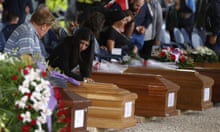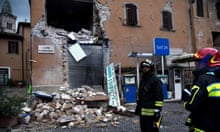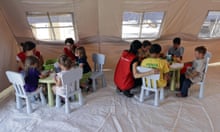Latest photos from Italy's #earthquake zone, where at least 247 people were killed https://t.co/F2JhseUQDr pic.twitter.com/M242H2EEv1
— Shailendra Nair (@shailendra_nair) August 25, 2016
Death toll surges as search for Italy's earthquake survivors continues – Thursday's developments
- At least 241 people killed and 264 injured in 6.2 magnitude quake
- Girl pulled out alive from rubble
- Italians queue to give blood
- Report: quake toll rises as rescuers struggle to free people
- Share your eyewitness accounts with GuardianWitness
Thu 25 Aug 2016 10.11 EDT
First published on Wed 24 Aug 2016 19.05 EDTLive feed
Italy, in particular the south of the country, is prone to earthquakes, because it lies close to the fault line where the Eurasian and African plates meet, constantly grinding and grating against each other, creating seismic tension that is relieved by major quakes. Italy’s major volcanoes, such as Etna, Stromboli, and Vesuvius, all lie close to this fault.
As well, Italy’s landmass has a series of smaller fault lines, in particular along the Apennine Mountains which run north-to-south along the ‘spine’ of the country. There are a number of faults along this range, which regularly rupture causing smaller quakes.
Wednesday’s earthquake came 1937 years - believed to be to the day - since Mt Vesuvius erupted in 79 AD, burying Pompeii and Herculaneum in tonnes of ash in one of the most catastrophic natural disasters in European history.
A 2009, 6.3 magnitude quake hit the Aquia region, about 90 kilometres south of this week’s event, in 2009. More than 300 were people were killed.
That catastrophe led to significant recriminations over lax building controls and the negligence of authorities who failed to warn residents a major earthquake could be imminent.
Two violent earthquakes within 10 days in northern Italy’s Emilia Romagna region in May 2012 left 23 people dead and 14,000 homeless.
Italy’s deadliest earthquake since the turn of the 20th century was in 1908, when 80,000 people were killed in the southern regions of Reggio Calabria and Sicily by an earthquake followed by a devastating tsunami.
Amatrice, one of the town’s worst hit by Wednesday’s devastating earthquake, is famous as the birthplace of spaghetti all’amatriciana, a pasta dish with a tomato-based sauce flavoured with guanciale, or cured pork cheek.
Food blogger Paolo Campana has launched a novel fund-raising effort to help the stricken area, asking that two euros from every plate of spaghetti all’amatriciana sold at Italian restaurants around the world be donated to the earthquake recovery effort.
The US Geological Survey has reported that an aftershock was felt overnight near Norcia in central Italy.
The magnitude was 4.7 with the epicentre about 7km east of Norcia, with a relatively shallow depth of 10 kilometers (6 miles). The latest temblor struck at about 5:40 am Thursday.
Norcia, which is about 170 kilometers (105 miles) north-west of Rome, is north of the towns of Amatrice and Accumoli levelled by the quake on Wednesday.
Death toll reaches 247, say authorities
The death toll from the earthquake has risen to 247, according to Associated Press.
It says Italy’s civil protection agency gave the updated figure early on Thursday, about 27 hours after the earthquake struck. __
"Broken Heart" #Italia #Italy #Amatrice #Heartquake #Terremoto #EmergenzaTerremoto #PrayForItaly #Terremoto24Agosto pic.twitter.com/2ORjalqVdv
— antonio rodriguez (@rodriguezmonos) August 25, 2016
#ForzaItalia #Amatrice #PescarDelTrono #Perugia #Italia #TerremotoItalia siamo con noi. pic.twitter.com/SSBqVL1xNs
— Nicola Napolitano R (@nnapolitanor) August 25, 2016
Italian Prime Minister Matteo Renzi struck a resolute tone after visiting some of the places hardest hit by the earthquake.
Right now we feel terrible pain. Italy is a family that has been hit and struck, but we are not going to be stopped. From tomorrow and in the next few months we’ll work on this [reconstruction]. But now, this is a time to pray and shed tears; a moment for respect and pain for all Italians for this huge shock.
18 hours after the quake struck, a girl is pulled alive from the rubble of Amatrice.
#earthquake Check the video after 18 h the #fireman rescued this little girl #alive https://t.co/5Mmd4iEIRP
— ReginaCatrambone (@ReginaCatrambon) August 24, 2016

Italy and further afield are fundraising for the earthquake response effort in Amatrice by cooking its signature dish.
The town, one of the worst-hit in Wednesday’s quake, is known for its spaghetti all’Amatriciana: a pasta dish with a tomato-based sauce flavoured with guanciale, or cured pork cheek.
In response to the disaster, Italian restaurants have put the dish on their menu and pledged to donate €2 from each sale to the Italian Red Cross.
According to CNN’s report, more than 600 restaurants are taking part in the so-called “#Amatriciana” initiative.
This article includes content provided by Facebook. We ask for your permission before anything is loaded, as they may be using cookies and other technologies. To view this content, click 'Allow and continue'.

This map, tweeted by the ABC’s London bureau chief, shows the difficulties authorities are having in reaching the areas affected by the earthquake.
These are the windy roads rescuers are having to try to move cranes and bulldozers in to Italy earthquake areas pic.twitter.com/7nN5mSHVHE
— Lisa Millar (@LisaMillar) August 24, 2016
This 53-second clip by Sky News’ Mark Stone in Amatrice, one of the worst-hit towns, shows what that process looks like on the ground: a crane working its way up what Stone describes as a “tiny, tiny road”.
“They’re trying to get whatever equipment they can from the larger towns down the larger roads and then up these tiny lanes into these small towns so that they can continue the recovery work.”
In the town of Amatrice, diggers make their way up tiny roads to help with earthquake rescue efforts- @Stone_SkyNews https://t.co/99lbNQiLLg
— Sky News Tonight (@SkyNewsTonight) August 24, 2016









